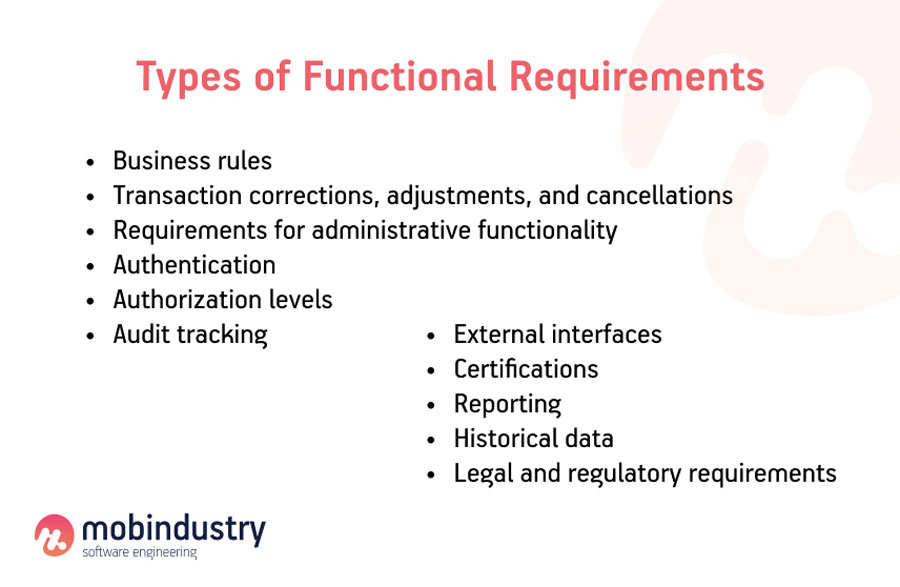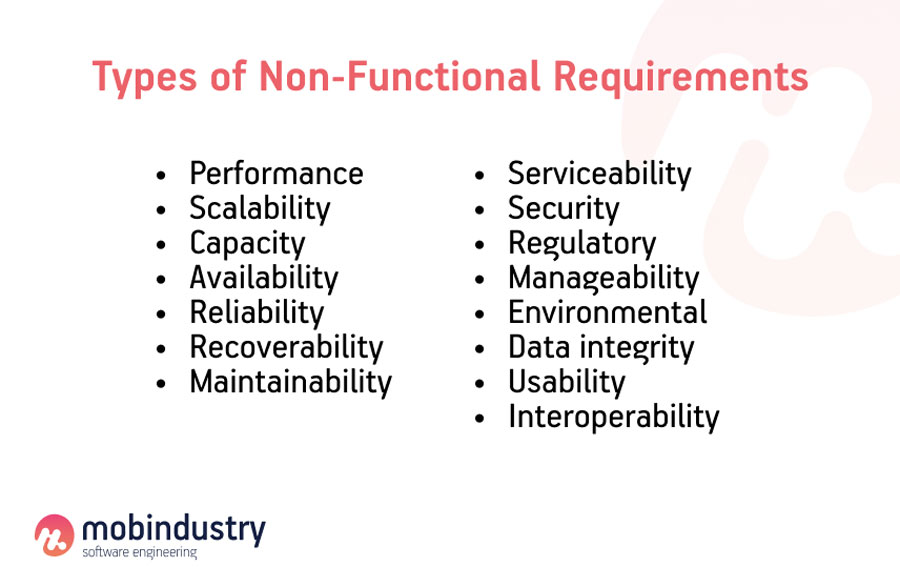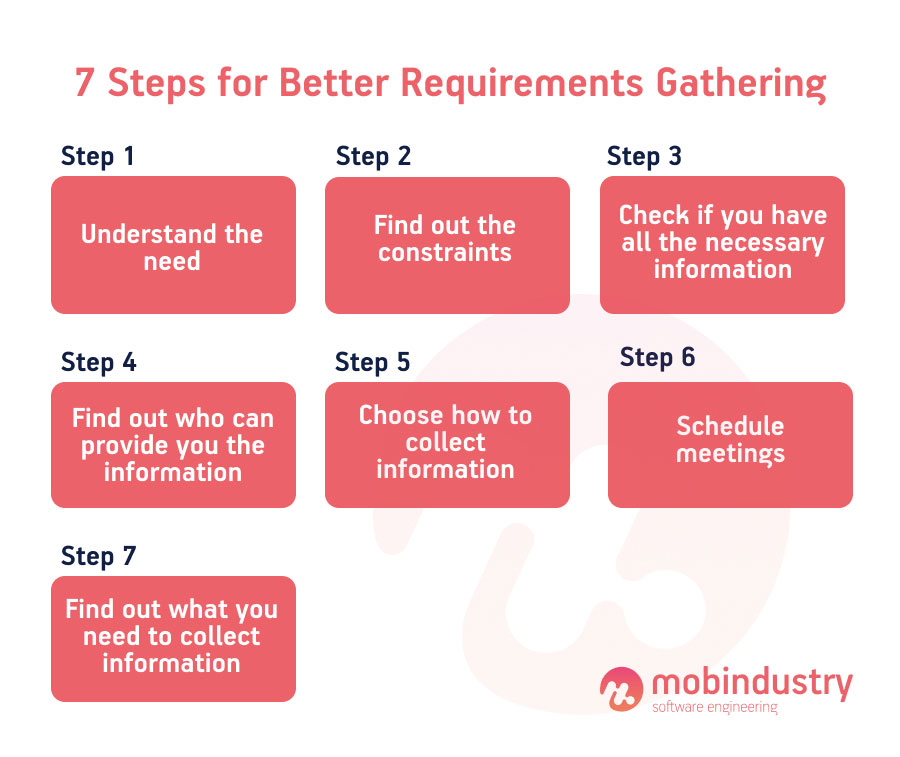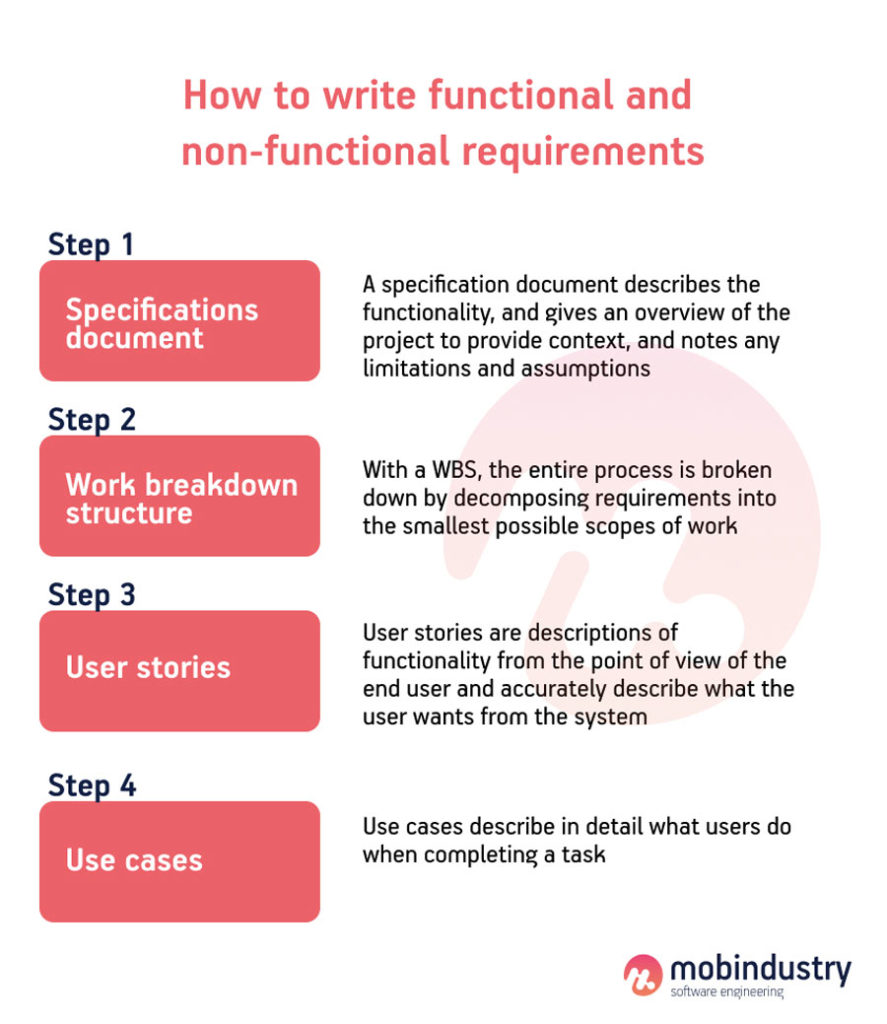Writing Clear Functional and Non-functional Requirements: Examples and Best Practices
Wondering what the requirements are to build a mobile app or website? Today, we talk about the difference between functional and non-functional requirements, give you a step-by-step guide to gathering them, and provide you with examples of each.
How requirements impact the software development process
If you want to create a project that will be successful in the long run, you should invest some time in formulating detailed requirements. Clear and well-defined requirements help development teams and clients ensure they’re working toward the same goals. Poorly formulated requirements can cause miscommunication between the team and the client.
But that’s all just words. Let’s look at some statistics:
- 68% of projects with efficient communication and well-defined requirements meet quality standards.
- 32% of IT projects fail because of unclear requirements at the planning stage.
- Poorly formulated requirements can increase the project timeline and budget up to 60%.
- Unclear requirements are responsible for 41% of the global IT development budget for software, staff, and external professional services.
The discovery phase in software development is the perfect time to create a list of both functional and non-functional requirements for your project.
Classification of requirements
Before we dive into types of requirements, let’s first define what a requirement is. A requirement states how a particular functionality or feature of a product should work. You’ll need a few types of requirements to create a good product.
- Business requirements describe a project’s high-level goals, objectives, and needs.
- Stakeholder requirements include information about what stakeholders expect from a particular solution.
- Solution requirements include product characteristics that meet the client’s expectations and business needs. They can be divided into two types:
- Functional requirements
- Non-functional requirements
Today, we’ll talk in depth about functional and non-functional requirements.
Functional and non-functional requirements help you:
- define terms and roles. Requirements help to avoid misunderstandings between the development team and stakeholders.
- reduce communication times. Good communication with a business analyst results in clearly defined requirements and a shorter development timeframe. It can help to reduce the time required for communication during the development stage as well as the project’s cost.
- more precisely estimate the project. Clear and detailed requirements lead to more accurate estimates of the development time and cost.
- spot possible mistakes beforehand. Functional and non-functional requirements can help you identify certain errors during the initial stages of development, saving you time and money.
- create more predictable projects. High-quality detailed requirements and wireframes help to predict the results and build a project that meets the client’s expectations.
What are functional requirements?
What is the difference between functional and non-functional requirements? Functional requirements describe how a system should behave when certain conditions are met. These requirements include technical details, calculations, data manipulation and processing, and other functionality that characterizes what a framework should achieve.

Functional requirements describe what the product should do. Such software requirements capture the intended behavior of the system. A functional detail should be aligned to a business need to avoid project failure. Functional requirements should include:
- details of operations executed on every screen
- descriptions of system reports and other outputs
- full information on system workflows
- a clear explanation of who will be allowed to create/modify/delete data in the system
- a description of how the system is supposed to fulfill applicable regulatory requirements and what compliance needs should be defined in the functional document.
Functional requirements cover the following:
- Business rules
- Transaction corrections, adjustments, and cancellations
- Requirements for administrative functionality
- Authentication
- Authorization levels
- Audit tracking
- External interfaces
- Certifications
- Reporting
- Historical data
- Legal and regulatory requirements
Examples of functional requirements
- The background color for all application windows will be #3333FF.
- Only employees at a certain level have the right to view revenue data
- The software system should be integrated with a certain API.
- When a user enters data, the system should send an approval request.
- The server should automatically back up the database every 24 hours.
- The system should allow only managers to access a user’s personal data.
- The system should shut down in the event of a hacker attack
What to consider when creating functional requirements
When coming up with a list of functional requirements, consider these categories of requirements:
- Business requirements. Define requirements that answer for the ultimate goal of the system. Here you can also mention things like approval workflows and authorization levels.
- Administrative requirements. Mention the routine things the system will do, such as reporting
- User requirements. These requirements describe what the user can do, like placing an order or browsing an online catalog.
- System requirements. Describe software and hardware specifications, system responses, and system actions.
5 benefits of functional requirements
- Serve as a guide for checking if an application provides all required functionality
- Help you determine the functionality of the system and subsystems
- Combined with requirements analysis, functional requirements can be helpful in identifying missing requirements and clearly defining the expected system behavior.
- Errors found while collecting functional requirements are easier and cheaper to fix than errors found later on
- Support goals, tasks, and user actions to simplify project management
What are non-functional requirements?
Now let’s talk about non-functional requirements. By definition, a non-functional requirement is a requirement that indicates how the system performs a particular function. A non-functional requirement describes how a system should behave and the limits of its functionality. Non-functional requirements answer for all the requirements that are left uncovered by functional requirements.
These requirements affect the user experience because they define a system’s behavior, features, and general characteristics.
When non-functional requirements are well defined and executed, they can make the system easy to use and enhance its performance. Non-functional requirements are product properties, so they mostly focus on user expectations.

Types of non-functional requirements:
- Performance (response time, throughput, utilization, static volumetric)
- Scalability
- Capacity
- Availability
- Reliability
- Recoverability
- Maintainability
- Serviceability
- Security
- Regulatory
- Manageability
- Environmental
- Data integrity
- Usability
- Interoperability
Get an example of the Discovery Phase documentation for your digital project
Examples of non-functional requirements
- Database security should be HIPAA-compliant.
- Users should be able to reach their profile data from any page within three clicks.
- The system should require users to enter their passwords every 60 days.
- The system must accommodate a minimum of three million concurrent users.
- All web pages should be able to load within three seconds.
What to consider when creating non-functional requirements
- Usability. These requirements focus on the appearance of the user interface and how people interact with it. They should describe colors, screen size, button size, etc.
- Reliability/availability. These requirements determine system availability (if the system needs to function 24/7/365, for example).
- Scalability. This section of the non-functional requirements should determine if the system will be able to handle future needs. For physical installations, this includes the availability of spare hardware and space to install it.
- Performance. Determine how fast the system needs to operate.
- Supportability. Specify if support is provided in-house or if remote access is required to external resources.
- Security. Set the security requirements both for the physical installation and from the cybersecurity perspective.
7 steps for better requirements gathering

Step 1. Understand the need
Your first step in gathering requirements is understanding the need, and your first goal is to meet with the client and answer the following questions:
- What outcome is the client looking for?
- Can we quantify that outcome?
- How many people will be impacted by this?
- Why do you do this?
- What sorts of performance is the client looking to get out of the solution?
- What issue is this solution supposed to solve?
Step 2. Find out the constraints
The next step is to find out your limitations and constraints. To find out the main limitations, ask the following questions:
- How much time do we have?
- What is the budget for the project?
Step 3. Check if you have all the necessary information
Assuming you now know what the limits of the project are, you can move on to the third step, which is to check if you have all the necessary information. Ask yourself, Do I know what I need to know? Here’s where you clarify all the previous requirements and find out what’s missing to get a full picture of the project.
Step 4. Find out who can provide you the information you need
Stakeholders in organizations — business managers, department heads, etc. — can provide the missing pieces of information you identified in step three, probably in the form of a document, something published on the internet, or a database.
Step 5. Choose how to collect information
Techniques for gathering requirements will vary depending on what information you need to collect. Here are some examples of requirement gathering techniques:
- Interviews
- Workshops
- Focus groups
- Document reviews
- Market research
- Benchmarking
You need to come up with a technique for every requirement. For example, say you have a requirement as to the number of users for the system. To get this information, you might interview an IT manager.
Step 6. Schedule meetings
Once you’ve figured out all the techniques you want to use, you can plan when to collect the information. When you’re developing a schedule, you’ll want to plan out the timing, duration, and techniques that will minimize the number of interactions with stakeholders.
Step 7. Find out what you might need to collect information
The next step is to ask yourself, What will I need to collect this information? It might be tools or a team of people. In this step, you have to ask yourself if you can collect the information by yourself given your timeframe and budget. After this step, you can move to implementing the requirements.
How to write functional and non-functional requirements
Functional and non-functional requirements can be written in a few different ways. Today, we’ll talk about some of the more common ones.

Specifications document
The most common way to write functional and non-functional requirements is using a requirements specification document. It describes the functionality required in written form, specifies the purpose of the project, gives an overview of the project to provide context, and notes any limitations and assumptions. Although most requirements specification documents are descriptive, it’s recommended to include visual representations of the requirements to make it easier for non-technical stakeholders to understand the scope.
Work breakdown structure
A work breakdown structure, or WBS, is closely related to a requirements specification document. With a WBS, the entire process is broken down by decomposing requirements into the smallest possible scopes of work.
User stories
The next approach you can use to write functional and non-functional requirements is user stories. These are descriptions of functionality from the point of view of the end user and accurately describe what the user wants from the system. User stories are written using the following formula:
“As a (type of user), I want (goal) so that (reason).”
One of the benefits of user stories is that they don’t require a lot of technical knowledge to write. User stories can also be used as a predecessor to specifications requirements to help determine user needs.
Use cases
Use cases are similar to user stories in the sense that no technical knowledge is required to write them. Use cases describe in detail what users do when completing a task.
For example, the use case for purchasing a product would describe each step in the buying process from the user’s point of view.
Mistakes to avoid when creating functional requirements
Here are a few common mistakes when creating functional requirements:
- Including extraneous information that can confuse developers
- Not providing sufficient detail
- Adding rules, examples, or purpose statements for anything other than the requirement itself
- Leaving out information that is absolutely necessary for a complete, accurate, and final definitive state of the requirement
- Defending the requirements when a requirement is modified instead of finding the best option
- Not mapping requirements to an objective or principle
Quick summary of functional and non-functional requirements
We hope this article has shed light on the world of functional and non-functional requirements. Here are the key takeaways:
- Functional requirements describe the particular behavior of a system when certain conditions are met
- Non-functional requirements describe how a system should behave and its functionality limits.
- Functional requirements with requirement analysis can be helpful in identifying missing requirements
- Don’t provide extraneous information that can confuse developers.
- There are a few different ways to write functional and non-functional requirements: using a specifications document, work breakdown structure, user stories, and use cases.
- For better requirements gathering, make sure you understand the project’s needs, find out its constraints, check that you have all the necessary information, find out who or what can provide you the information you’re lacking, choose how to collect this information, schedule meetings, and find out what people or tools you might need to collect the information.
If you want to create functional and non-functional requirements for your future mobile app or if you have any questions regarding this topic, contact Mobindustry for a free consultation.

